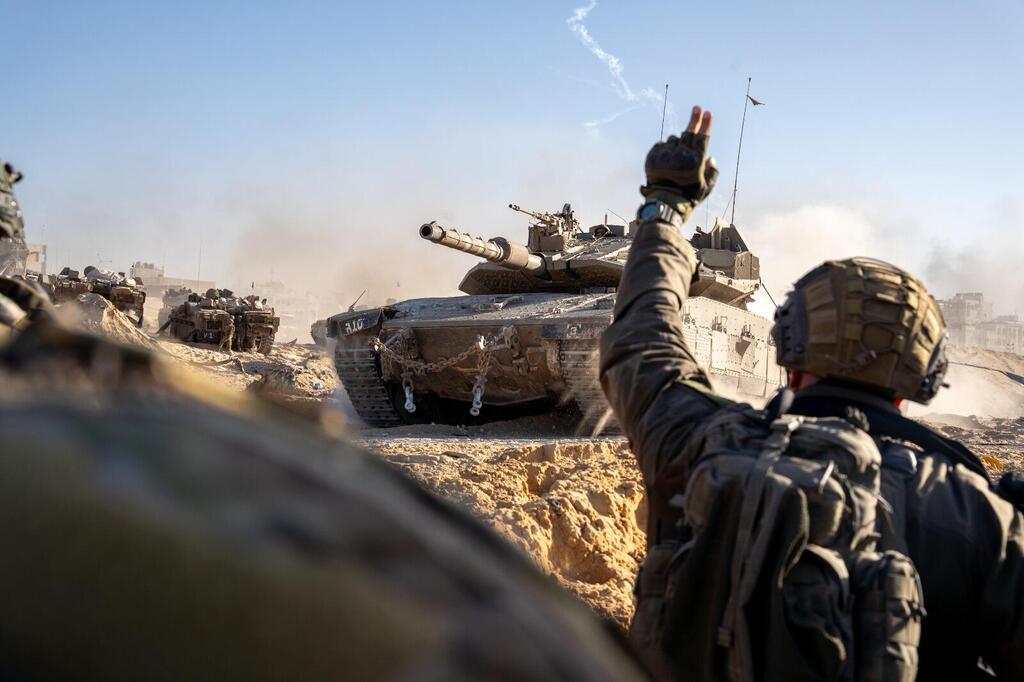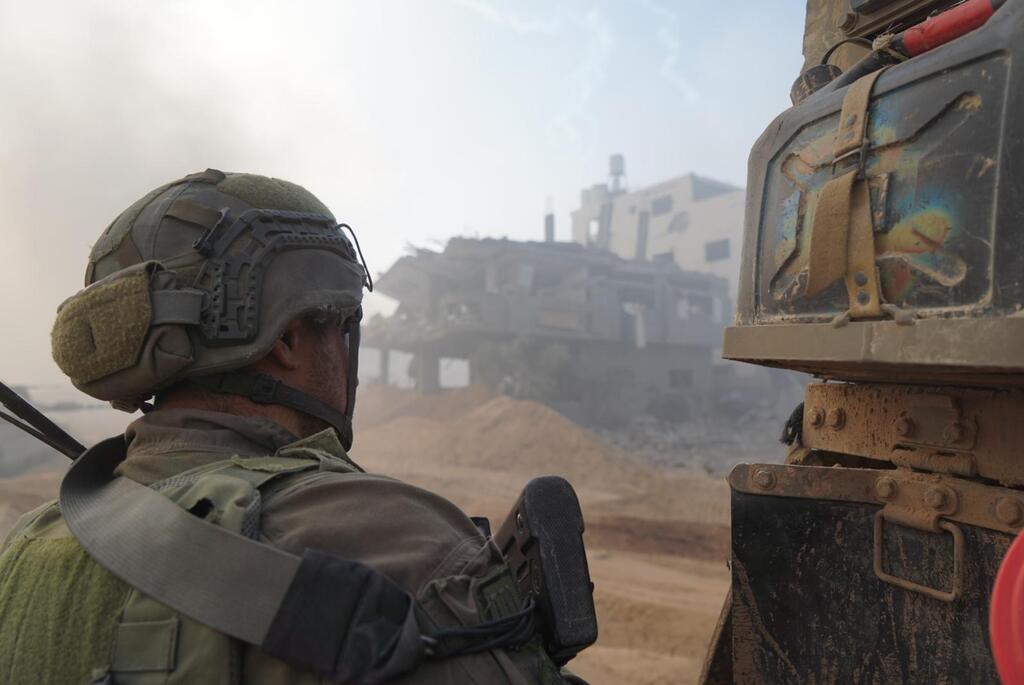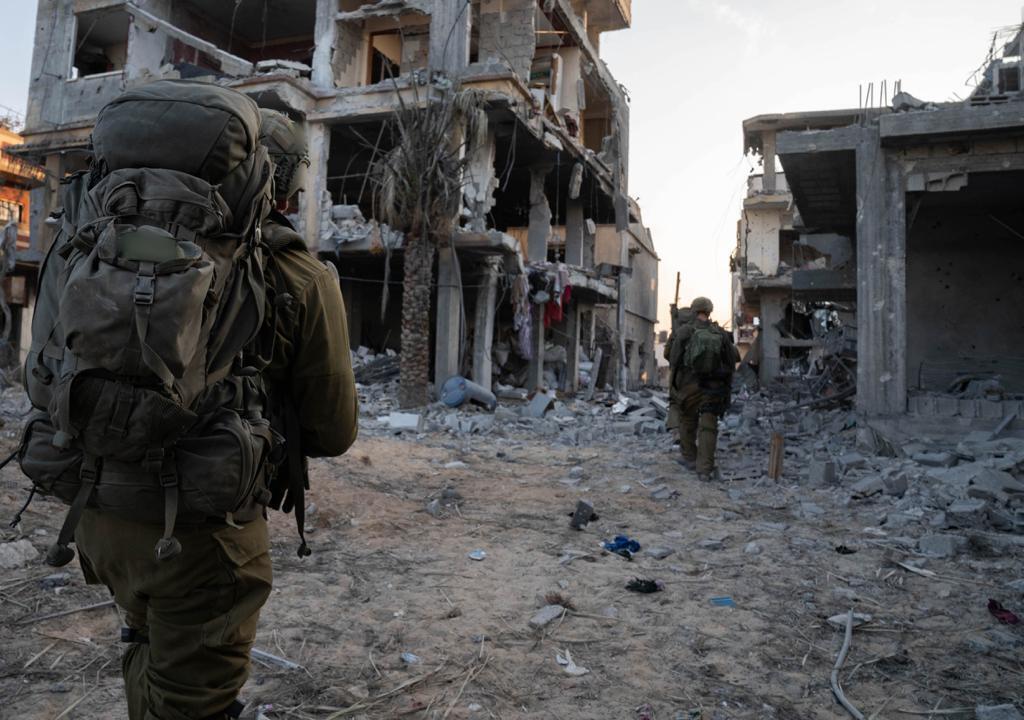A hint of frustration and perhaps even disappointment colored President Joe Biden's words on Thursday, as he expressed his anticipation for a speedier Israeli Defense Forces response in the Gaza conflict to an American reporter. Even within Israel, some eyebrows are being raised at the seemingly leisurely pace of the forces in the northern Gaza Strip and around Gaza City.
Read more:
But the truth of the matter is that the IDF is intentionally moving at this measured pace. This is a fresh combat strategy developed in recent years by Chiefs of Staff Gadi Eisenkot and, to a larger extent, Aviv Kochavi. It's not just a strategy - the IDF has also equipped itself to "fight slow", with the main aim of keeping casualties to a minimum, both among its own ranks and the non-combatants on the opposing side.
There are four key elements that catalyzed the creation and execution of this strategy. The first relates to Israel's heightened sensitivity towards the loss of its soldiers. This likely springs from the deep-seated national trauma of the Holocaust and the Jewish-Israeli culture that reveres human life, particularly those lost in battle, seen as making the ultimate sacrifice for the well-being of others. The outcome can seem somewhat paradoxical at times: the loss of a soldier in combat is perceived as a more horrific event than the death of a civilian in an attack. This perception has guided the IDF in their development of this measured approach to combat in recent years.
The second driving force behind this approach is the imperative to avert harm to civilians on the opposing side. This stems less from lofty moral principles and more from the necessity of preserving legitimacy. All of Israel's adversaries, from Hezbollah to Hamas, have recognized that the global community holds the Jewish state to a different standard, expecting a higher level of combat morality than what the Americans, for instance, exhibited in Vietnam, Afghanistan, or Iraq.
The world echoes the sentiment that a people who have historically borne the brunt of persecution, pogroms, and genocide should be held to a different benchmark. The quest for moral legitimacy and a commitment to uphold international warfare laws also played a part in shaping the IDF's current modus operandi in Gaza.
The third ingredient in the creation of this combat style is the advent of technology, which enables a soldier on the ground to receive high-quality intelligence and particularly precise strike assistance from a multitude of different sources. This technology reduces the need for direct, face-to-face - or barrel-to-barrel - confrontation with the enemy.
A container with Hamas munitions uncovered
(Video: IDF Spokesperson's Unit)
The fourth element is the combat style adopted by the terrorist armies surrounding us, often referred to as "the phantom enemy". Neither Hezbollah nor Hamas engage in open combat with the IDF, instead, they hide until forces approach. They then emerge from clandestine underground or surface locations, fire their weapons, detonate a bomb or launch an anti-tank missile, and vanish. This necessitates locating the enemy in the fleeting moments of their appearance and being able to fire back quickly enough to neutralize them. This calls for a more measured, deliberate pace of combat.
Bulldozing their way through
These four components have led the IDF to refine a concept that was already present in the U.S. armed forces, known as combined warfare. Fundamentally, this implies that a Hamas squad ready to launch an anti-tank missile will be detected even before they can fire, and neutralized by an aerial missile before they can retreat to safety.
In essence, the adversary on the battleground, whether in Jabaliya or Shati, confronts not just a single fighter from the Givati Brigade or an advancing tank, but the full might of the IDF - in the air, on land, and occasionally at sea - within moments of initiating an attack on our forces.
For instance, let's consider a battalion leader from the Nahal Brigade currently deployed in Gaza. If he spots around 15 terrorists in a line of houses or ruins that lie in his path, he won't directly engage them. Instead, he communicates with the fire control headquarters located some distance behind him, sometimes even within Israeli borders, briefly describing his requirements. Then, the commander in the attack cell determines whether to dispatch an attack helicopter or a fighter jet, or to simply employ a few rounds of highly accurate ground artillery rockets.
IDF Chief of Staff and Shin Bet chief conduct a field assessment
(Video: IDF Spokesperson's Unit)
The aircraft and helicopters aren't required to take off and reach the location. They are already circling nearby and theoretically can launch weapons at the target designated by the general in less than a minute. However, this target needs to be precise, verified, and authorized, which takes a few additional minutes. Once this is done, the battalion commander guides the pilot or helicopter operator to the exact rooftop or window where the terrorists were spotted, and they handle the rest: a one-ton, precision-guided bomb (JDM) is dropped on the target, which is merely 218 yards away from the IDF force. The bomb's precision allows it to be deployed so close to our forces.
Enemy’s underground shafts are the clear priority
It is crucial to underline that this deliberate operating approach only begins after detailed preparation and pre-emptive fire bombardment, all before the forces have even set foot on the battlefield. This entire procedure demands time - an abundant amount of it - significantly more than what was required in past wars such as the Six-Day War and the Yom Kippur War. In those conflicts, the IDF charged forth hastily, incurring numerous casualties, but achieved their mission swiftly.
In the present day, the IDF functions with as much caution and slowness as possible. This 'slow and steady' approach becomes even more pronounced when dealing with adversaries like Hamas, who lurk beneath the surface in battle-worn cities, only to surface via hidden tunnel exits. This style of warfare, where the enemy is subterranean, eats up even more time than conventional warfare, where the enemy is visible above ground. The tunnels must be found, the enemy coaxed into emerging, the tunnels obliterated, and only then can the advance resume.
The aftermath of the aerial strikes preceding the ground operation makes it challenging to spot the tunnel exits. Hence, it is necessary to patiently wait for the enemy to surface from these tunnels to ascertain their exact locations. Amid all this, extreme caution must be exercised, given the potential threat of hostages being held within these tunnels.
At first glance, this may seem like a drawn-out, almost excessive method, but as the saying in Hebrew goes, "there's a method to the madness." Every decision, every delay, every painstaking measure is part of a carefully considered strategy to ensure the mission's success with minimum casualties.
One would be hard-pressed to declare the method isn't paying dividends. The current strategy is indeed showing its worth. The IDF is remarkably close to the heart of Gaza City, and yet, they haven't incurred the severe losses one would anticipate if they had engaged using traditional combat methods. Any military worldwide recognizes the high casualty rate associated with urban warfare, affecting both the attacking force and innocent civilians.
The IDF's current operational approach in Gaza is built on precise intelligence, advanced weaponry, and ground troops adept at navigating through urban terrain, even by breaching walls when necessary. This tactic is intended to outmaneuver the enemy, preventing them from triggering prepared explosives or firing anti-tank missiles from pre-set ambushes, designed to target forces advancing through the expected routes along the streets.
Artillery kicks in the door
There are a couple more ingredients in this combat recipe that are worth mentioning. First up, we have the tanks and APCs that roll into the strip boasting their trendy "windbreaker" accessories. But these aren't just for show - they protect these big guys from anti-tank missiles and RPG rockets. Now, the second and somewhat bigger deal is the "rolling screen of fire" that acts like a protective, fiery curtain for the advancing tank and infantry force.
This sizzling screen not only safeguards our guys but also gives a tough time to any enemy who dares approach. The primary components of this "fire screen" are the artillery, cannons, and ACCULAR rockets that are fired from terra firma, along with the fighter planes, helicopters, and UAVs strutting their stuff in the air.
On occasion, the force has to do a bit of a boomerang move and operate in the same field cell where it was active before. Seems there are some stubborn terrorists still hanging out in the tunnels below. But that's expected, and the IDF would rather do a rerun and coax these guys above ground again than engage directly in the confines of their expansive tunnel array.
The slow and steady approach may have its hiccups, but it's nothing if not thorough. Plus, it gives those innocent bystanders a fighting chance to skedaddle from the combat zones even while the action is happening right in their backyard. This is a big win in the game of global legitimacy. Now, the downside of this approach is, unsurprisingly, its snail's pace to reach the goals. The international audience, especially our friends in America, aren't exactly known for their patience. They're not just tapping their feet; they're actively trying to score a cease-fire for Hamas, which would pretty much be a get-out-of-jail-free card from the IDF's squeeze play.
This is where the worthiness of the political echelon is tested in real-time. Their challenge is to break it down for the Western policymakers - from President Biden to Congress members and senators and all the way to the leaders of Europe and Canada - what exactly Israel is up to and how they're going about it. They need to make it crystal clear that time is not just on their side for taking out Hamas with minimal loss of forces, but it's also playing into the hands of the humanitarian cause that's so close to their hearts.
While U.S. armed forces took their sweet time clearing ISIS from Iraq, not to mention over a decade to deal with Al Qaeda post-9/11, they’re still perplexed and ruffled about the IDF’s rhythm as it rolls deeper and deeper into the enclave. This, however, can largely be attributed to internal politics, where the Biden administration is trying to convey a message of success and control, ever wary of Donald Trump’s impending return into the Presidential foray.







